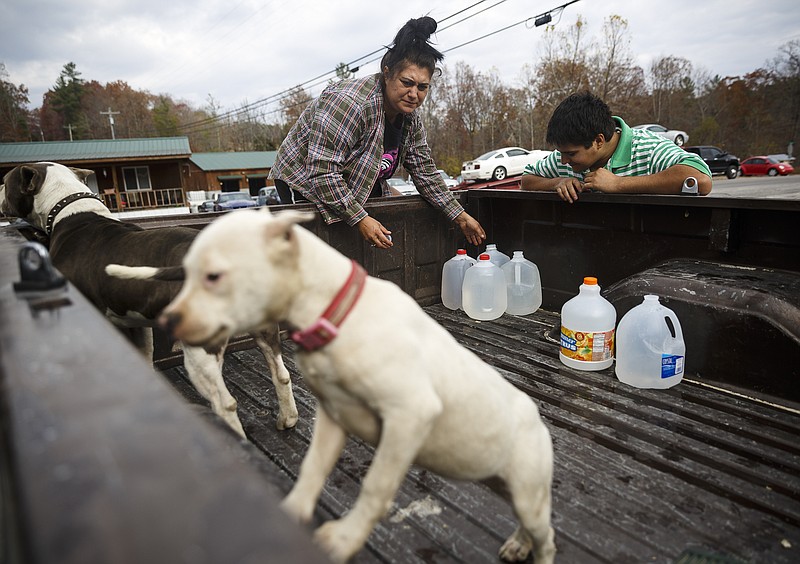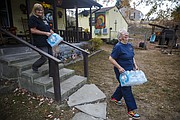Photo Gallery
Drought here to stay: With no rain in the forecast, city is on target to break record for driest year
Chattanooga's rainfall is 20 inches below its yearly average, and a local meteorologist says the current drought is on pace to be the worst in the city's history.
The months-long drought has starved the area of rainfall, drying forests and fields to a crisp and setting the stage for a bout of ongoing wildfires that have scorched the Southeast.
Chattanooga has received only 25 inches of rain this year, nearly a 20-inch deficit from the yearly average, according to meteorologists with the National Weather Service in Morristown, Tenn.
Since the beginning of September, only 1.7 inches of rain have fallen - almost 8 inches below what residents usually see over the same period.
Gov. Deal bans fireworks in much of drought-stricken Georgia
ATLANTA (AP) - Due to the ongoing drought and the risk of wildfires, Gov. Nathan Deal has banned the ignition of all fireworks in much of the state. News outlets report that Deal issued an executive order on Monday to expand a Level 1 drought declaration across 110 of Georgia's 159 counties. The affected counties are across northern Georgia as well as all of the counties that make up metro Atlanta. The Level 1 declaration requires public water systems to inform customers about the dry conditions and encourage conservation, though it doesn't restrict water use. WABE-FM reports the National Weather Service forecasts that the drought will continue at least through early-2017.
And that's not changing anytime soon.
"I have very low confidence that we would get anything measurable in November. It's just the pattern we've been in," said Jessica Winton, a meteorologist with the National Weather Service.
Winton said one of the causes of the region's arid conditions lies farther to the south over the Gulf of Mexico. Ordinarily, the Gulf generates precipitation for Georgia, Alabama and Tennessee, but a persistent high pressure system has a stranglehold on that process.
"Right now, it's kind of over the Gulf, which is where it has been setting up and sitting, and that basically just keeps a cap over that moisture so it can't really go anywhere," Winton said.
"To be able to get out of the drought we need one of those slow, steady rains that just stays for a couple of days," Winton said.
Paul Barys, chief meteorologist for WRCB-TV Channel 3 agreed, adding that the drought is on pace to be the worst in the history of Chattanooga. Almost eight inches is needed by the end of the year to get out of an uncomfortable first place. The next driest year on record is 1904 with 32.68 inches.
"There's a lot of moisture [in the Gulf], it's just not coming up," he said.
More than 545,000 people in Tennessee alone live in areas that have received the most intense drought designation possible, exceptional drought, according to the U.S. Drought Monitor. In Georgia and Alabama, another 3 million are similarly affected.
While the desert-like conditions and clouds of wildfire smoke are generally uncomfortable, some communities feel the pain of drought more acutely than others.
The residents of Luminary in Bledsoe County, Tenn., have already received an emergency shipment of drinking water since the private wells many in that community rely on are insufficient, according to Lloyd Draper, fire chief for the Luminary Volunteer Fire Department.
"There are some people whose wells are like 400 feet deep and those people seem to still have water. But the shallower wells, a lot of them have pretty well dried up. Those that do get water out of them, it's kind of dirty," Draper said.
On Friday, Tennessee American Water announced its mobilization of a "water buffalo," a 1,000-gallon water tank, to the community. The tank was filled in Dunlap and Dayton and the city of Dayton has promised to keep it filled for the drought's duration.
Draper said residents have already received several hundred gallons of water from the tank, as well as bottled water that was provided by the Tennessee Emergency Management Agency.
"People bring their jugs up and they bring as many as they have," Draper said.
So far, Luminary is the only community to require such direct intervention from Tennessee American Water, but Daphne Kirksey, the utility's external affairs manager, said the drought is causing headaches elsewhere.
Residents in Whitwell and Suck Creek have received notices to limit nonessential water use.
"Don't wash your car. If you're cleaning off your driveway, use a brush or a broom, don't use a waterhose to get the dirt or leaves off of it," Kirksey said. "Avoid watering your garden if you don't have to."
With the Tennessee River close at hand, Hamilton County is under no such strictures, and Kirksey said it is unlikely the county will reach that crisis point, but Gov. Bill Haslam has declared a ban on burning effective until Dec. 15.
After that, as now, forecasters and citizens will be looking to the sky for some sign of relief that may be a long time coming. Meteorologists say it may not be until early spring that the water table begins recovering all that it has lost.
"A drought feeds on itself," Barys said. "It won't last forever. It will break down, but it's going to be a slow break."
Contact staff writer Emmett Gienapp at egienapp@timesfreepress.com or 423-757-6731. Follow on Twitter @emmettgienapp.

